There are two different ways to wire solar panels: series and parallel. There are a few considerations to this ‘argument’ but by the end of this blog post you will hopefully have enough info to determine which is right for you, as well as the reason that most of the wiring diagrams here on EXPLORIST.life are designed in series. Here are the two ways; series and parallel, drawn out:
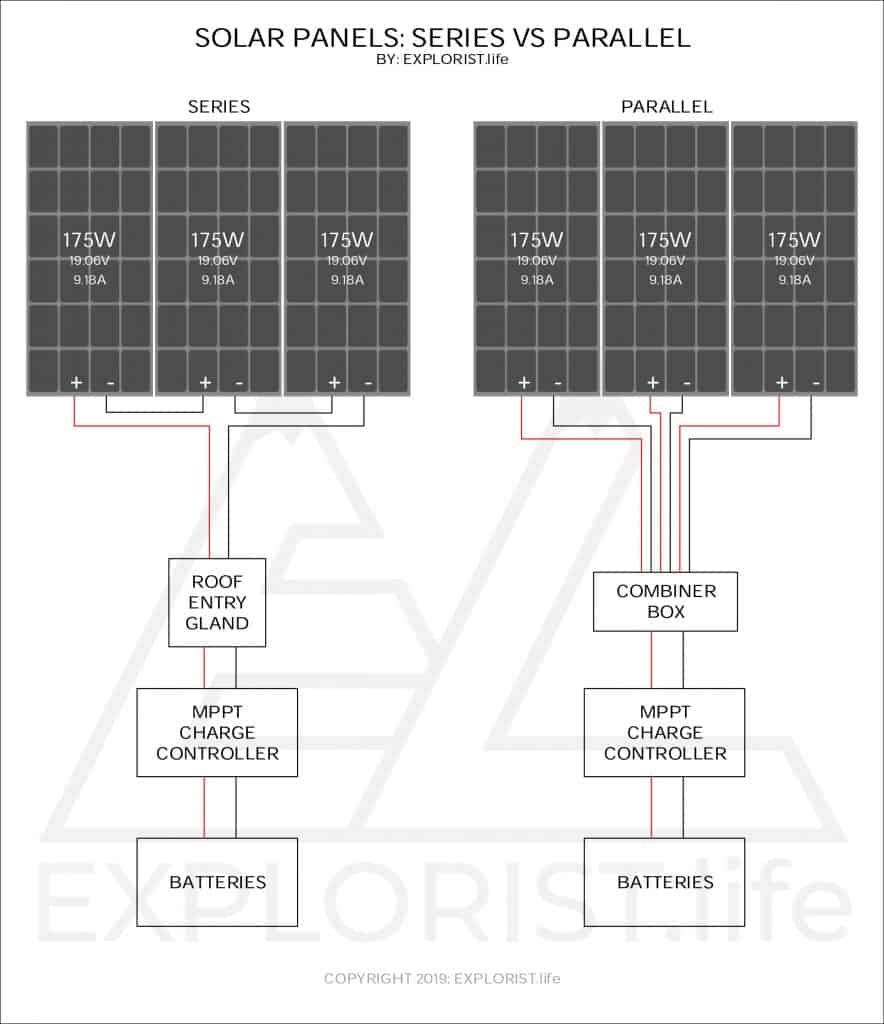
Solar Panels in Series vs. Parallel
All parts on this first diagram are, for the most part, the same. The panels are all the same 175-watt panels, each has some kind of roof entry gland, a charge controller, and the batteries.
Voltage & Amps of wiring Solar Panels in Series vs Parallel
The diagram below introduces the concept of what the voltage and amperage you can expect to see from wiring your solar panels in series vs wiring your solar panels in parallel.
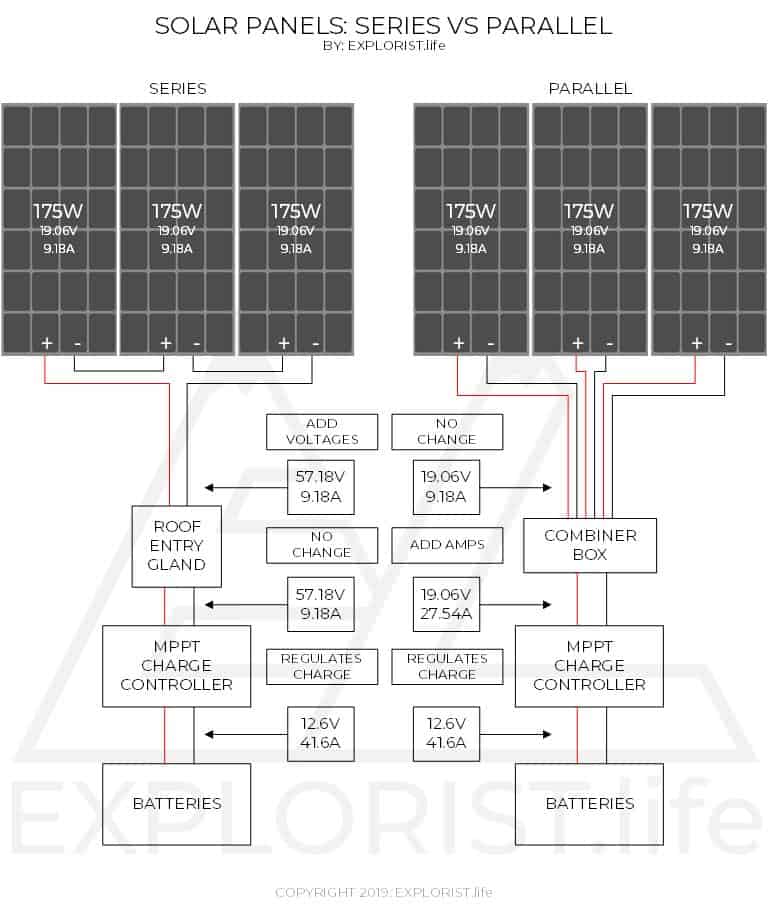
The big thing to remember here is; when you wire solar panels in…
…Series you add the voltages together.
…Parallel you add the amperages together.
It’s important to understand that wiring your solar panels in parallel requires more equipment. To find out what we need, we need to have a good grasp of the voltage and amps we can expect to see at each point between the solar panels and the batteries. Now, we are going to be doing some math here, but if your eyes glaze over at this part, just push through! The entire blog post is NOT just about the math and the further you make it down the page, the more it will make sense. Let’s start with solar panels in series:
Voltage & Amps of Solar Panels Wired in Series
Starting at the top; we’ve got 3, 175W panels with stats of 19.05V and 9.18A. Since these panels are wired in series, we need to add the voltages of the combined panels and leave the amps alone. This gives us 57.18 volts and 9.18 amps. These figures stay consistent all the way down to the charge controller.
The charge controller then takes that 57.18V and 9.18A and regulates it down to 12ish volts where it will be charging the batteries at 41.6 amps.
Voltage & Amps of Solar Panels Wired in Parallel
Let’s switch over to the other side of the page and run-down the parallel system.
Starting at the top, we’ve got the same 175w panels. Each of these panels wires will run from the panel to the rooftop combiner box at the same panel stats of 19.06 volts and 9.18 amps. After the combiner box, we have successfully wired the panels in parallel which means we need to add the amps and leave the volts alone. This gives us 27.54 Amps at 19.06 Volts from the combiner box, down through the roof, and over to the charge controller.
The charge controller then takes that 19.06 Volts and 27.54 Amps and regulates it down to 12ish volts where it will be charging the batteries at 41.6 amps.
Now that we know the voltage and amps we can expect to see at each section of wire, we can now start figuring out what size of wires we can use.
Wire Sizes for Solar Panels in Series vs Parallel
The wiring diagram is fairly straightforward on this one, so check it out:
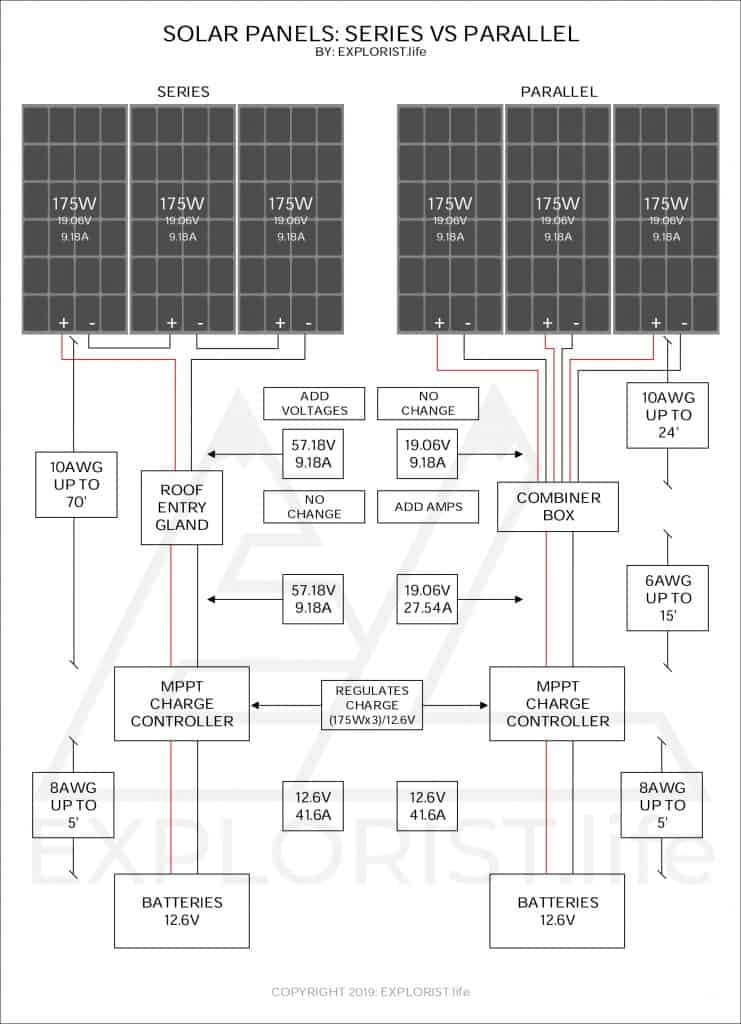
For series, at the 57 volts and 9 amps, we can use 10 gauge wire for anything under 70 feet from the panels to the charge controller.
In Parallel, we can use 10 gauge wire from the solar panels to the combiner box, but only if the longest wire length is shorter than 24 feet.
After the Combiner Box, since our amps ramp up to a little over 27, we’ve got to step it up to 6 gauge wire but we have to make sure our solar controller is closer than 15’ for the 6gauge to be big enough.
Also, those lengths don’t give us much wiggle room. We REALLY have to try to make the runs as short as possible because if we have much voltage drop, it further decreases what our charge controller has to work with in terms of voltage.
Remember, if the voltage of the solar panels is lower than the voltage of the batteries, they can’t charge.
On both setups, both series AND parallel, 8 gauge wire is recommended from the charge controller to the batteries given we keep that distance under 5 feet, which is pretty feasible as that’s good system management anyway.
Breakers for wiring Solar Panels in Series vs Parallel
Now, we need to talk about breakers because we all know that none of this matters if your wires rub through, short out, and catch your camper on fire. Dramatic, yes; but let’s get to it.
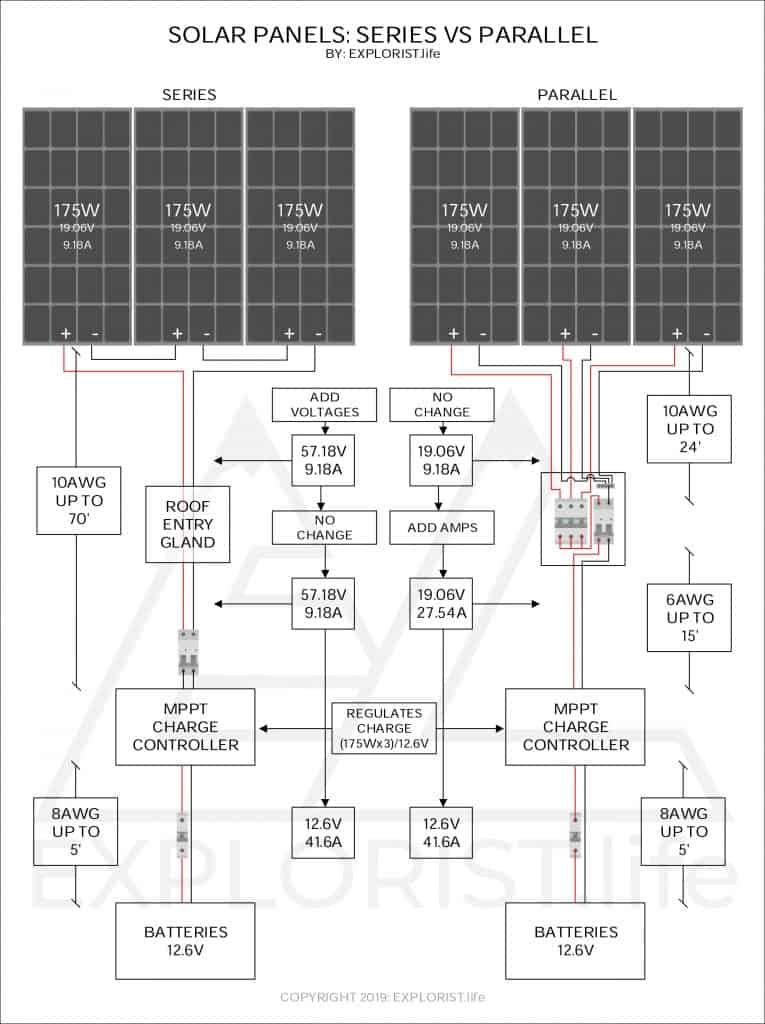
For solar panels wired in series, the wire from the solar panel to the charge controller technically doesn’t even need a fuse (more on that in a later blog post), but it does need a disconnect (which can be a breaker… so, let’s just call it a breaker, shall we?). Also, a breaker/fuse is needed between the charge controller and the batteries for a total of 2 breakers
For solar panels wired in parallel, you need to have a breaker/fuse on each of the sets of wires going to each panel (3), a disconnect (or breaker) on the wires going from the combiner box to the charge controller, and another breaker on the wires going from the charge controller to the batteries for a total of 6 breakers.
That example is just for a 3 panel system. If you want to parallel more panels together, you’ll need to add one breaker per panel you add to the array.
MC4 Connectors for Wiring Solar Panels in Series vs Parallel
MC4 Connectors are the way most solar panels are wired together. Sure, some people just cut off the connectors and splice the wires together and that’s fine, but for those of us who like the ease of use of the MC4 connectors, there are a few differences between parallel and series.
Solar panels typically have MC4 connectors built onto the ends of their built in wires like this:
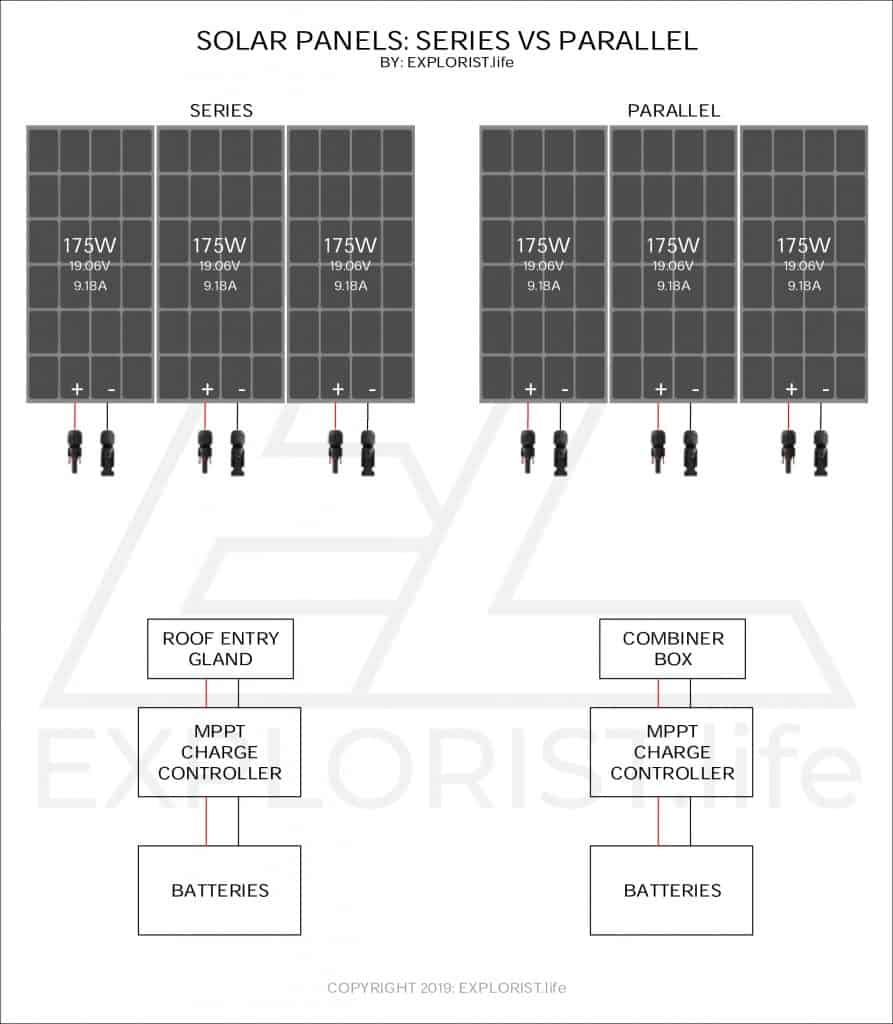
And in the following picture, this is how you would be wiring the panels up in series and in parallel using MC4 connectors:
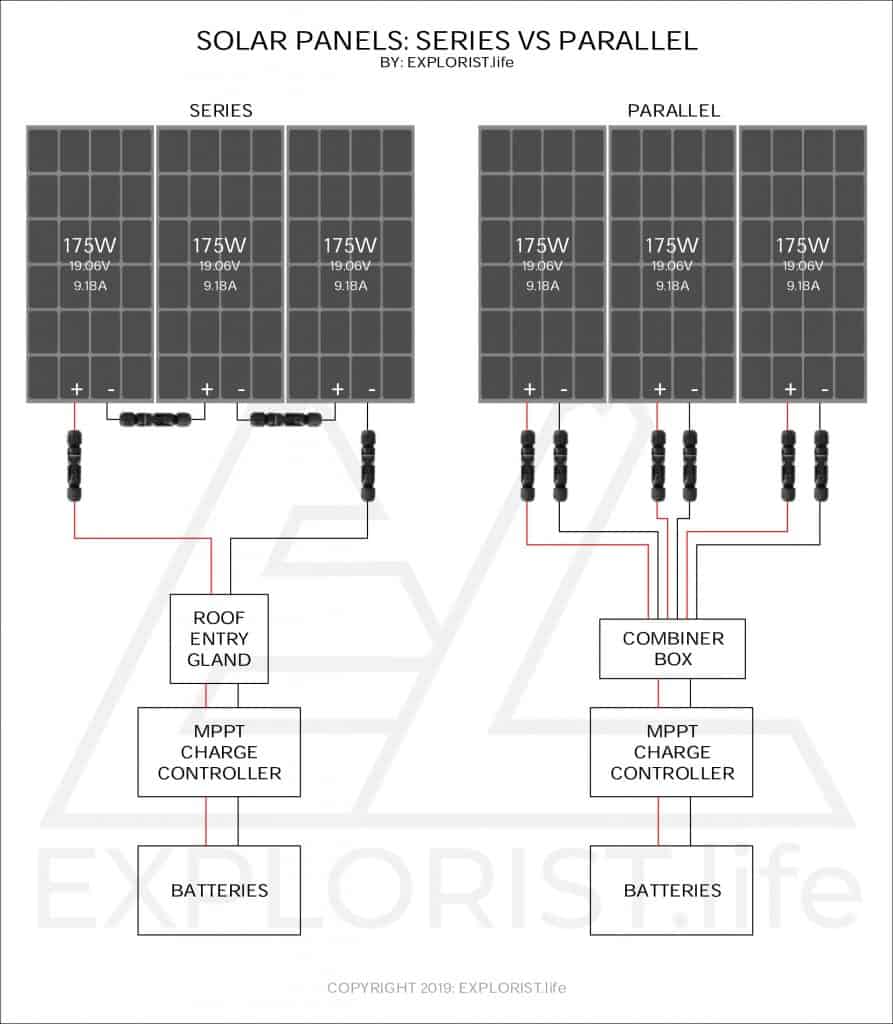
In 90% of installations, when wiring in series, the solar panels can be placed close enough together so that the positive lead of one panel will reach the negative lead of the adjacent panel. This means you won’t need extra MC4 connectors to make the inter-panel connections.
If that solar panel arrangement works for your setup, you’ll only need 1 pair of MC4 connectors for the whole series.
For Parallel wiring, you’ll need a pair of MC4 connectors per solar panel you use.
Parts List for Wiring Solar Panels in Series vs Parallel
At the bottom of the diagram below, you can see the hardware parts list, side-by-side, showing what it takes to wire solar panels in series vs parallel:
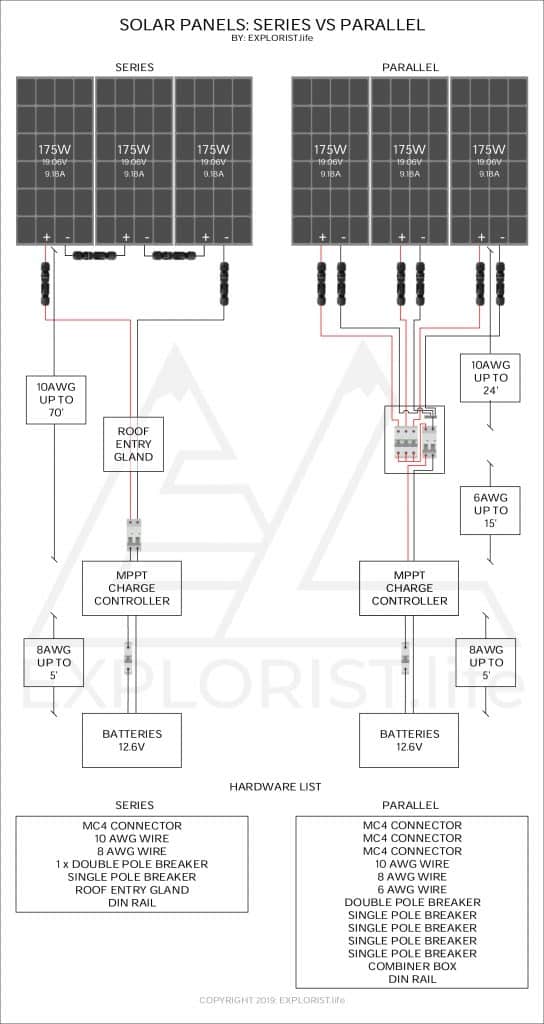
Common arguments for parallel over series.
Recently we’ve been getting a ton of comments arguing for wiring solar panels in parallel and they always go something like this:
“I want max solar output from my solar panels and if I wire in series, park under a tree, and get shading on part of my array, It significantly decreases power to the entire array.”
and…
“I want max solar output from my solar panels and if I wire in series and a panel breaks It significantly decreases power to the entire array.”
In our 3+ years of being on the road, neither of these have been a problem.
Fortunately, I’ve developed a highly-sophisticated strategy for solving both of these problems and still wiring in series and lucky for you, I’ve made diagrams for both of them.
The first diagram fixes the problem in regards to getting max solar output when your camper is parked near a tree that’s causing partial shading to your solar array.
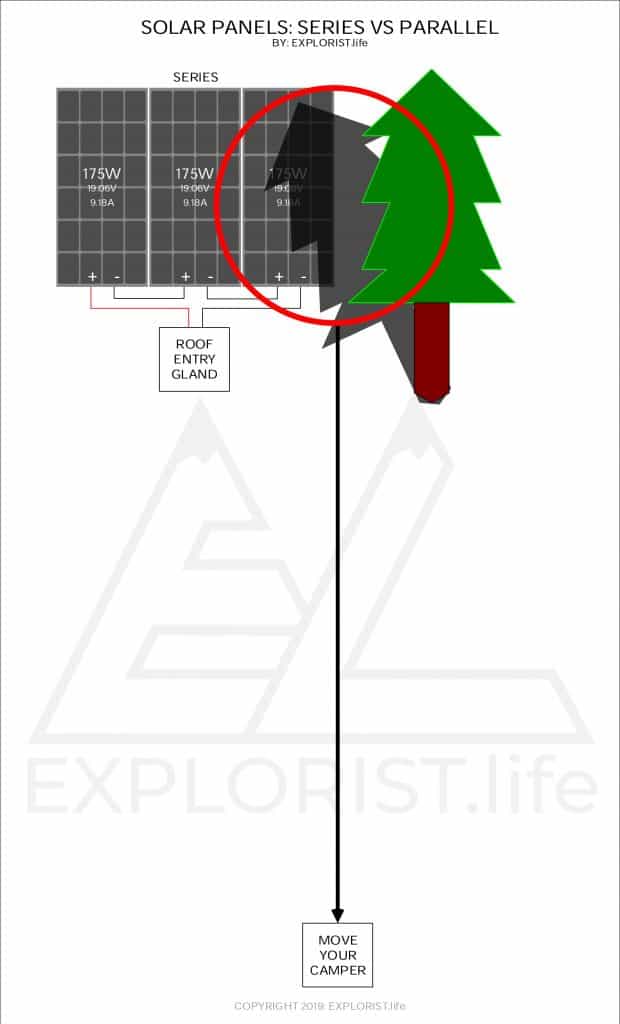
This next diagram fixes the problem in regards to getting the max solar output of an array with a broken panel.
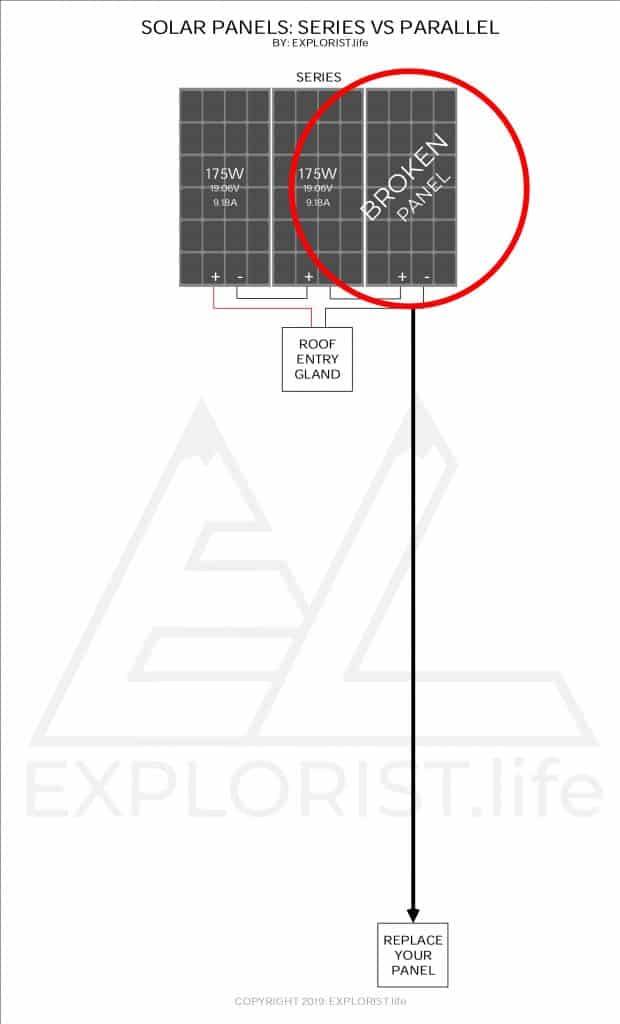
There have been tests done showing how one bad panel or shading on one panel will decrease the output of the entire array. All of that is true; I’m not debating that.
My point is this: If you are TRULY worried about getting the maximum output from your solar panel array; park in the sun and maintain your solar panels.
A story about wiring solar in series vs parallel
The first setup we had on our camper was in parallel because the theory of an MPPT controller regulating 100 volts down to the 12v useable by the battery was confusing to us.
After a few months on the road, we just weren’t getting enough charge to keep up with our usage even though we had plenty of panels.
We called up the manufacturer of our charge controller (Midnite, at the time) and they recommended that we re-wire our panels to be in series.
We did just that and had an immediate and drastic improvement of solar power, particularly on overcast days.
Why?
To charge a 12v battery bank, you’ll need closer to 14 volts (depending on battery chemistry. 14.4 for Lithium) to actually start charging. Most single solar panels in the 100 – 200 watt range have voltages in the 18-20 volt range.
If you wire in parallel, this means you’ll only have a range of 6 volts to work with where your solar panel can make power. Basically, this means that your solar panel needs to be operating at 75% capacity before it will even charge your batteries at all.
If you wire the same solar panels in series, using the same panels as above, you’ll have about 57 volts to work with. This means that, through the power of the MPPT controller, each panel only needs to be able to muster up 25% of its voltage capacity before it can start making amps in a 3 panel series.
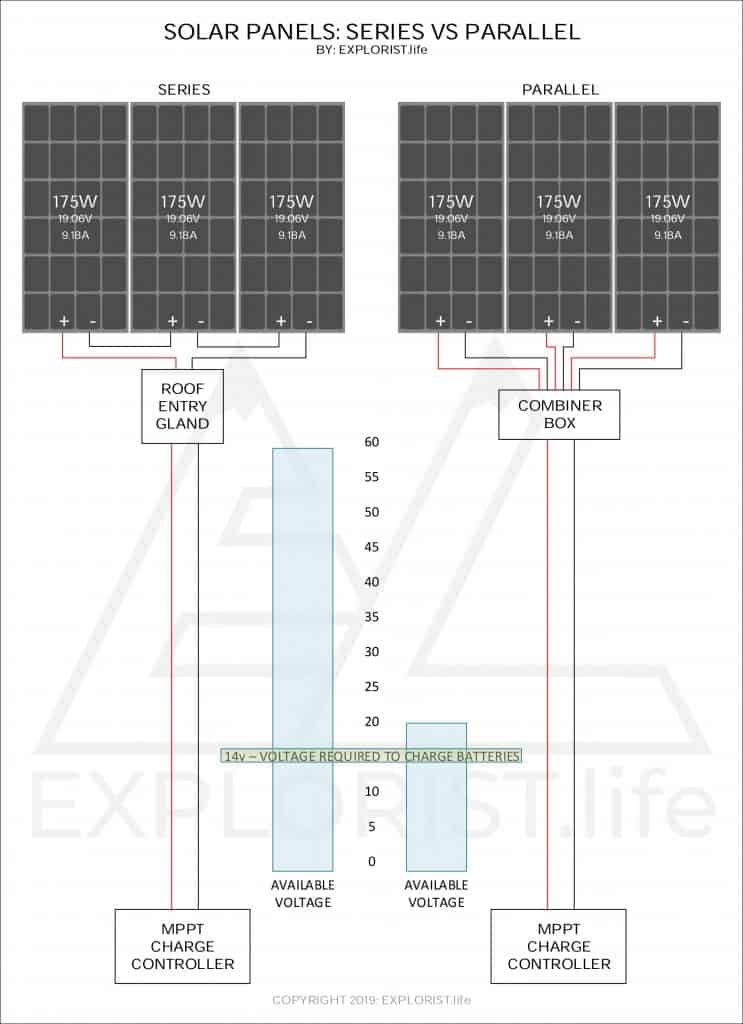
This is why we were seeing such a drastic increase in power output, specifically during cloudy days.
This same reason is also why our panels will start charging earlier in the day and later into the evening as the sun angles are low. There’s just a bigger range of voltage for our charge controller to work with.
Also: as solar panels get hot, their max voltage decreases. If it’s REALLY hot out, depending on the panel; it’s actually possible that the voltage of the panel can fall enough so that it’s not producing enough voltage to allow amps to flow into your batteries.
Parking location and equipment maintenance are two things you have control over. Air temperature, clouds, and how long the sun is in the sky are things you have no control over. Pick your battles.
Summary & Comparison
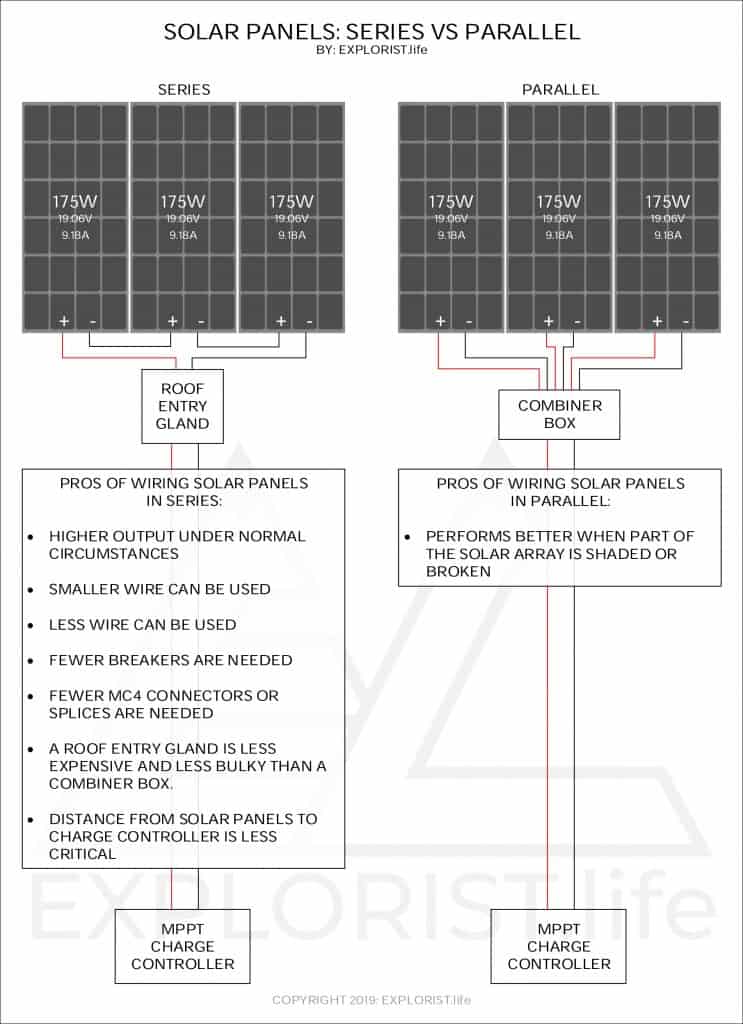
Last thing. It’s worth noting as voltages get higher, they also get more dangerous and care MUST be taken to not touch live wires specifically once they get above ~40V. Regardless of voltage, though, when working with solar panels, it’s a good idea to cover them up or flip them over when possible so they are ‘off’. Remember… panels in series will have higher voltages than parallel wired arrays.
Now that you have made a decision about how to wire your solar panels for your DIY Camper Van electrical system, it’s now time to learn what kind of charge controller you’ll need to convert the power from your solar panelsinto a form of power useable by the batteries. You can check that out here: https://www.explorist.life/how-to-choose-a-solar-charge-controller-for-your-camper/
Everything that you are learning here is put to use in our FREE Interactive Solar Wiring Diagrams. If you haven’t yet, check them out as they are a complete solution for a camper van electrical system. Check them out here: https://www.explorist.life/solarwiringdiagrams/
Remember, this is just one part of a full camper van electrical educational series. To see all of the individual guides, click here: https://www.explorist.life/diy-campervan-solar
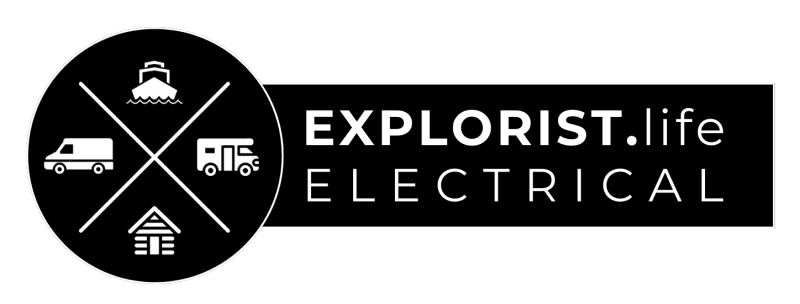
102 Responses
This is fantastic information laid out in an easy to understand way. I really learned a lot from this as I explore more and more about home solar. Thanks for writing this!
Great work, a lot of good information. Thank you! But what about charging efficiency – I mean – as far as I know the bigger the difference between input voltage and battery voltage, the less efficient the conversion is….
That’s not necessarily true in all cases.
What voltage is considered ‘too high’ for an RV installation? I am going to install four (4) 190 watt panels with outputs at 22.78 volts. In Series and using your Explorist calculator, it comes to approx 107 volts. Just Series. If I wired in Series/Parallel combination that maximum voltage is around 54 volts.
The biggest charge controller I’ll recommend in an RV has a max voltage of 250V.
Thanks Nate , you explication , it all now makes a lot of sense . At the moment I have a 6x110w panel set up wired in pairs series / parallel and it works well . We are about to purchase a new van and I was trying to work out how to wire 6 panels in to 2 strings via 2 controllers . Using 2 Victron 100/30 MPPT controllers I can wire the 3 panels in series using 160w 18v panels . My calculations should give me a total input around 60amps .
Sounds about right! You could keep them in the same array if you liked. Like this: https://shop.explorist.life/shop/all-products/camper-wiring-kits/solar-charging-wiring-kits/1000w-solar-charging-wiring-kit-2x-200w-12v-battery-bank/
Hi
if you have 4 panels, to each, could you put the panel on each in series and parallel into control, would this give the best of both worlds, i know if means more wiring, and the controller can handle it
Usually, yes. As long as the array voltage is over 20V higher than the battery bank charging voltage.
Hi, Thank you very much for the very comprehensive explanations but just one thing I do not get it is why for the series connection I need a double pole breaker on one side and a single on the other, I would expect both sides double pole breaker. And will both be the same size ?
For fuse sizing, check the solar array wiring diagram examples at the bottom of this blog post: https://www.explorist.life/3000w-inverter-400-600ah-400-to-1200w-solar-camper-solar-kit
Great explanation, great information and simple enough to understand! and exactly what I was looking for in my van build – series it is!
Great! Glad it helped.
Thanks for the information you provide Nate! I have purchased two 370 Watt Solaria Power XT – 48volt panels
seen here:
https://static1.squarespace.com/static/568f7df70e4c112f75e6c82b/t/5e697989327a9a7e2b9a0fd1/1583970700115/Datasheet_PowerXT_Resi-370PD_Rev_04.pdf
I am wondering if would you wire these in series or parallel and why? Reason I ask is the difference in this case changes the charge controller needed from Victron 100/50 to Victron 150/45.
Wiring them in parallel would be a great choice for those panels.
I had 4 pannel each is 400w having voltage 46v…my inverter mmpt voltage range is 30vdc to 80vdc…and voc is 102v and charge controller 50A…which connection is best 2 series then parallel or 4 panels in parallel?
If your panels are 46V each and your max voltage input for your MPPT is 80V, you will have to wire all 4 panels in parallel.
Gday mate, great advice for an amateur like me living off grid and cashless. Can I ask for your advice on how to get the best out 6 x 24v panels I was given:
Max Power 185w
(VOC) Open-Circuit Voltage 44.7v
(ISC) Short-Circuit Current 5.45a
Voltage at Point of Maximum Power 36.28v
Current at Point of Maximum Power 5.10a)
Maximum system voltage 1000v
I have a 1 x 50amp controller (Max. PV Array Voltage (VOC) 95VDC) and looking at your drawings I thought I could get away with a parallel system (I’ve got lots of fittings) seeing that I can only have 95v max. Can you tell me if there’s a better way of going about it.
All 6 panels in parallel is your only option with the equipment you have. 2 panels in series will exceed the max voltage rating of your charge controller if it gets cold out.
Hi Nate, great article! I looked through all the comments trying to find an answer but am still stumped on the parallel vs series math post-solar controller. In both scenarios you listed, there’s 41.6 amps charging the battery from the controller. I could be wrong, but I thought that the controller will charge the battery with the amount of amps its being given. So in your examples, the controller would charge the battery at 9.18 amps in series and 27.54 in parallel, correct? If not, where do the extra amps come from?
The reason why I ask is because we have two mismatched panels (one is 100W, I believe, fixed to the roof, and the other is a floating flexible 105W that we disconnect every time we move) that I’m thinking about connecting in series. (I would basically cover the roof panel with a towel, disconnect the positive from the controller and connect it to the negative on the flexible panel, then connecting the positive of the flexible panel to the controller.) I know that we would probably have fewer hours in the day available to charge, but the hours it would be charging it would be charging faster, right? I also don’t completely understand the way the MPPT works, but in our current setup, it seems like we’re getting about half an amp of current off of about 5 watts of solar. I’m just worried that if we switch to series, we’d only get .25 amps of current (roughly) off 5 watts. I hope this makes sense, and I apologize if these questions are a bit n00bish. Thanks!
1: Think about it like this: If the solar array is delivering 600w… the batteries will charge at 600w. How those watts are delivered is the difference. So… if 3x solar panels with panel specs of 20V and 10A are wired in series, that would give us an array voltage of 60V and 10A (60V x 10A = 600W). Our battery bank needs to charge at, say, 14.4V. So… our charge controller will regulate those 60V down to 14.4V. Since we know how many watts are coming in AND how many volts we will be charging at… we can use V x A = W to see that we would be charging our battery bank at 41.46A (W / V = A).
For mismatched panels, here’s how that works: https://www.youtube.com/watch?v=jejro4zkl8I&list=PLmvhcyi4n0TVgcroqXl5QvJM0afUes_zX
@Nate Yarbrough, goodness gracious, I don’t know how I couldn’t figure that out myself. I guess I didn’t make the connection that the panels were delivering watts rather than either volts or amps depending on how they’re wired. Sorry about that!
My next question would then pertain to volts vs. amps being delivered. Let’s use your example of having 600W of solar. Let’s assume that we’re getting 500W, or 83% capacity, given current conditions. If they’re wired in series, does that 83% translate to volts, amps, or both? As in, would you be getting 10A at 50V from the panels? And if you’re in parallel, would you get 25A (83% of 30A) at 20V from the panels? Or is that not really how it works? This is where solar power really starts to get fuzzy for me. Thank you so much for your help!
Don’t worry about panel inefficiencies. You’ll drive yourself crazy trying to determine if series or parallel is better with the sun angle at 35 degrees and the outside temperature of 65 degrees F with 26% cloud cover and a butterfly landed on your array which shaded one cell. Don’t go down that path. That’s a surefire way to never actually get anything done due to analysis parylasis.
Do this: Make your solar array at LEAST 20v higher than the charging voltage of your battery bank while keeping your amperage low enough you can use 10 awg wire for all of the solar wires.
This usually involves either series OR series parallel.
A purely parallel wired array, IMO, is rarely a good idea (Unless you have panels that operate at +20V over your battery bank voltage).
@Nate Yarbrough, good to know! I only have two ~100W panels, so my max amps would be no more than 11 amps. I’m running 6mm^2 wire since AWG isn’t available easily in Europe, which carries 11 amps no problem. HOWEVER, because I only have two panels, I’d have to run them in series in order to get 20V above the battery voltage, so I think I’ll do that. Thanks so much for the patient help!
I think my original confusion came from thinking that voltage only serves to ensure that the battery can be charged (i.e. keeping it at least 5V above the battery voltage) and isn’t associated with the actual deliverance of power, which I now realize isn’t how it works.
Nate, I realy appreciate all the information that you post. I’ve got a 600w kit for a off grid Cabin and it came with no instructions what so ever. I was so pleased when I found your explanations.
Thank you.
Dalton Cardoso
Nate, Thank you for your simplified explanation on Series vs Parallel. I have a few questions for you.
I am in the planning stages of an fifth wheel RV solar setup. I now have a much better understanding of the use of the wire requirements of each system. I will have 400AH LiFePo4 batteries and had planned on somewhere between 1200-2000 watts of solar. I also will have a 50amp DC to DC charger with a built in mppt controller that will accept up to 32 VOC . I’m told it can take 800 or more watts easily. Given the wire size going forward would I be better off going with a parallel system for the DC to DC charger and series on the rest of the roof to a separate MPPT controller, Or should I just settle on a smaller panel to the DC to DC charger. Just trying to wrap my mind around all of this.
I would recommend wiring your entire roof array to two Victron Smartsolar MPPT charge controllers so they can communicate back and forth with each other to sync their charging for the entire array.
If you are using less than 1450W of solar, you could use a single charge controller.
Nate, thanks so much for again very useful article.
So simple and easy writen for the novice to understand and make a chice.
Cheers
Dooby
This was, by far the best article for solar panel use. It answered all of my questions, so I can move forward with my application. Great Job!
Thanks so much for the copious amount of information here, and throughout your site, and especially all your replies to a lot of interesting situations!
In a parallel situation, what’s the reasoning behind needing a disconnect for each panel right before the larger breaker that goes to the MPPT?
For the shady reverse bias question you answered above, would that still apply if a panel was disconnected from the circuit or only when voltage is applied in revers? I’m toying with the idea of doing 5 panels or so, 3 stationary on top, 2 retractable underneath that form an awning when parked (thus roughly covering the alternator’s portion of the charging on days we aren’t going anywhere). Would love it if you could poke holes in that idea.
The dual pole disconnect is required for ungrounded solar arrays as per NEC 690.17 (B).
The reverse bias issue would be only for if a cell, or a few cells of a panel are chronically shaded. There SHOULD be no issue if the entire panel is chronically shaded. I would, though; for efficiency sake, put the two ‘different arrays’ (top vs bottom) on 2 seperate charge controllers.
Hey Nate, I’m so thankful for your all of the clear and concise tutorials. I have a somewhat unique situation. I have (2) 300w Renogy panels (38.8V, 9.3A) that are going on my ProMaster, and a lack of foresight has made it so part of one of my panels sits directly below part of the awning that we have mounted. I understand the concept of moving out of a shaded area or replacing a broken panel, but I wonder if this configuration will leave this panel almost consistently partially shaded. I wonder if you think having 38.8v to work with in parallel is efficient enough to keep up on cloudy days, or if a couple partially shaded diodes isn’t so much to worry about in series if I have 70ish volts to work with. Sorry for the long winded question. Thanks again!
Let me bring up another problem… Chronically shaded cells can create what’s called ‘reverse bias’ which, if it happens enough can burn out the cells on the panel. Shade on a panel that just happens from time to time, or for a few hours a day will not damage them, but if you put, say, tape over a few cells; it could very much damage the cells.
That said… if you want to try it; try to plan out your roof array so you can test it in both series and parallel as you wish. With a bit of pre-planning, it shouldn’t take more than an hour to re-connect your panels from series to parallel by using MC4 connectors. This way you can real-world test the output instead of just speculating (which I would be doing if I gave you an actual answer to your question.)
I would, though, start with wiring them in parallel, though, as 38v should be plenty for the MPPT to do it’s job.
Hi Nate, I do a lot of national park camping in shaded areas and would love to know what you think the best way to set up my pannels/ system .?I’m currently running 4x 350w 18v pannels(series parallel) with a victron 100/70 mppt controller and 2 x200ah lithium batteries. I have room for another 2x 300w pannels that i can connect to a DC to DC 50A enerdrive charger that’s connected to vehicle alternator. Most times we are parking in shade as it’s hard to get full sun. We are fairly power hungry as we run our split system at night.
I see nothing wrong with the way you’ve got it currently set up.
Thank you Nate for your effort in educating folks like me. This is best training document I have seen by far.
I have a situation where I have limited space on my camper, so I can go with 2 panels (100Watt and 175Watt). [I know I could use 2 similar 100 Watt panel but why not get 75 extra watts if I can fit it, is what I am thinking].
These are the specs:
Renogy 100 Watt 12 Volt Extremely Flexible Monocrystalline Solar Panel
Open-Circuit voltage: 22.5V
Short-Circuit Current: 5.75A
Renogy Monocrystalline Solar Panel 175 W
Open Circuit Voltage: 21.6V
Short Circuit Current: 10.35A
Now you make a convincing argument to go with series connectivity (with the voltage difference and its ability to charge Lithium Battle Born batteries). But the wattage calculation is throwing me off on what I should do:
Series Wattage: (22.5+21.6)*5.75 = 253.6 watts
Parallel Wattage : 21.6*(5.75+10.35)=347.7 Watts
Am I not better off connecting it in parallel? Or does this difference not matter and it will be different from what comes out of MPPT?
Parallel, in that case, would produce more wattage, but series connection may allow the array to charge for a longer time-span throughout the day. I know that doesn’t answer your question specifically, but this is a borderline case where it’s simply tough to tell which would work better.
Thank you Nate for your effort in educating folks like me. This is best training document I have seen by far.
I have a situation where I have limited space on my camper, so I can go with 2 panels (100Watt and 175Watt). [I know I could use 2 similar 100 Watt panel but why not get 75 extra watts if I can fit it, is what I am thinking].
These are the specs:
Renogy 100 Watt 12 Volt Extremely Flexible Monocrystalline Solar Panel
Open-Circuit voltage: 22.5V
Short-Circuit Current: 5.75A
Renogy Monocrystalline Solar Panel
175 W
Open Circuit Voltage: 21.6V
Short Circuit Current: 10.35A
Now you make a convincing argument to got with series connectivity (with the voltage difference and its ability to charge Lithium Battle Born batteries). But the wattage calculation is throwing me off on what I should do:
Series Wattage: (22.5+21.6)*5.75 = 253.6 watts
Parallel Wattage : 21.6*(5.75+10.35)=347.7 Watts
Am I not better off connecting it in parallel?
Parallel would indeed yield more wattage, but series may allow for longer charging throughout the day. This is a borderline case where it’s impossible for me to, at this time, speculate which would yield more power over the course of each 24hr period. Time for a coin flip?
This has been crazy helpful! Thank you. I’m looking to put as much solar on the roof as possible .Will end up with 4 x 100w 12v panels & 5 x 30w 12v panels. I’m thinking I need to have the different sizes on two different series circuits. Is that correct? Also do I need an extra component to connect both series circuits to my MPPT controller? Thanks again for your help.
Hey Ash, I just released a blog post talking about that concern specifically. Here is a link to that: https://www.explorist.life/using-mismatched-solar-panel-sizes/
Hi, I really like this article and it cleared something up for me. However, my next question is whether I can wire my batteries in parallel while my panels are wired in series or will that not matter? I don’t want to go blowing myself up by doing something I shouldn’t. I don’t think it would be a necessarily bad thing but I could be missing something. If it makes a difference please let me know. I’ll be asking around until then. Thanks again.
You should check this out: https://www.youtube.com/watch?v=6G3Mo_OHmQY
Thank you for the information and the great article. Helped me a lot.
Nate,
Your website (and youtube videos) has become my go-to spot for info re my van build electrical plans. I plan to rely heavily on your 200 amp hour – 300 watt solar diagram when starting my build. I do have a couple questions for you:
1. What are the pros/cons (if any) of multiple panels (e.g., 3, 100 watt panels) wired in a series, versus a single panel (e.g., 1, 300 watt panel)? As a novice my guess is that it has something to do with the voltage output, but would love to hear your thoughts.
2. If I were to go with a single 300 watt panel, would that change anything in your 200 amp hour – 300 watt solar diagram?
Thanks so much for all the info you are putting out there. I’m sure you have really helped countless people!
1x300w solar panel vs 3x100w panels likely won’t matter much because a 300w panel is a higher voltage and will provide enough voltage to the charge controller so it can adequately do it’s job. 200w panels on the other hand… may not have enough voltage to deliver to the MPPT so it can adequately do it’s job.
This helped a bunch, but now I think I am in the more complex Series-Parallel situation… I am upgrading an existing rig and it came with GP-190w up top and an external plug that uses a Renology 200w suitcase panel. I am now wanting to add another Rich Solar 190w(18v/5.5a) panel up top and possibly 2 90w (18.2v/5.3a) narrow panels to max out roof space. (*Although I am starting to think I give up on narrow panels and find a way to fit a 3rd 190 above my MaxxFan to make things easier…) Can I find a series-parallel solution to run to a single MPPT 100/50 controller, or easier to run 2 controllers leaving the external suitcase plug on it’s own controller? I have a Go Power PNW in there now and planned on upgrading to the a Victron MPPT 100/50, so I would have the second controller already.
Panels in the same array really need to be matched. So…
Sor your setup, I’d recommend 3 x 190w panels on the roof on one charge controller and the 200w suitcase on a separate charge controller.
The only way to put everything on one charge controller would be to match the panel sizes on the ground and the roof to be the same.
Hi Nate – Kudos for all that you’re doing here! Very cool. In your Series V Parallel example, you have the solar controller taking the 19.06 Volts and 27.54 Amps and regulating it down to 12ish volts where it will be charging the batteries at 41.6 amps. How is this calculated? Where does the 41.6 Amps come from, please?
Thanks in advance,
Chas.
Hello Nate great info here.
i have 4 x 270w panels, i will wire in them in pairs, 2 at the back will be series and 2 at the front will be series. each pair will go to their own MPPT
where should my DC breakers go?
can i put the battery output cables from both the MPPTs straight to my 2x 6v 370Ah batteries wired in series? or do the MPPTs need to be synced?
all the best
Carl
If both of your panel pairs are wired in series, you just need one dual-pole disconnect solar array next to the charge controller. If wired in series, no fuses are needed between the solar panels and the charge controller. From there, both MPPTs would connect into you DC Distribution busbar (or battery terminals if you are not using a busbar). The MPPT’s do need to be synced.
Hey man, props on your work here. I am really thankful for the bundled content so well explained!
Im thinking about putting this solar panel construction on a tiny house and also use a wind generator, since Wind and Sun might compensate the lack of energy Input.
my question is now: Can I just wire the wind generator and the solar panels in series or has there to be a special wiring?
Thanks a lot for you help man!!!
Justus
The wind side of things would need to come from a totally separate controller than the solar side of things. Unfortunately, I’m not much help with wind power as it has limited usage on RVs/Campers and I’ve yet to dive into the necessary products on that front; but I do know it’d need to be separate/independent from solar.
Where are amps factored in…? If I have 480W (6x80W) and with higher 145v in series, what does a low 3.85 amp get me? Is this low amount of amperage detrimental to the build?
Duh… Voltage x amperage = Watts. figured it out. Thanks Nate!
That’s it! Nice!
Hi Nate,
Still working on my design to install 4 panels/680 w solar and Victron 3000w inverter/MPPT 100/50 controller in an existing Coachmen Prism 2300DS electrical system. Your videos have been very helpful!!
Once I pick up my 2300DS this weekend I can better scope out install options then I’ll contact you for help in finalizing the plan, but I think as a start putting my panels in series will best for me.
Regards,
Chris
You should check out the Genasun GV-Boost Solar MPPT Controller. The advantage of redundancy in a parallel system is needed in various situations. Each panel will need a boost controller to ensure the up conversion to the nominal charge requirement. This is a more complex and expensive system. This system is commonly used in the marine environment for the fact that changing out a broken panel is not an option when you are out at anchor. But this can be applied to RV’s too.
Thanks for the lead and I’ll check it out in order to educate myself about it, but when there is a solution as simple as moving the RV or replacing a broken panel; I would struggle to recommend a more complex and expensive solution. Remember… I’m teaching total beginners how to install solar and electrical; so it needs to be simple.
Good Day Nate , I like that Solar panels is better to be wired in Series to keep the cost down which is important. For the battery bank if using 24v, is it OK to have them wired in both Series and Parallel with 12V batteries and have them wired to a 24V Inverter? It is important to have longer run times. I have watched some videos and the guys say that a 2V system is much better and cheaper. If that is the case, then I would rather have 24V batteries and wire them up in Parallel and connected to a 24V Inverter. IMO, 12V batteries are cheaper, so am confused as how the 24V batteries could be cheaper!!! I do prefer to use LifePO4 batteries as they are more reliable, light and efficient than Lead Acid batteries.
If a 24v battery bank was better and cheaper, I would have all of the wiring diagram on https://www.explorist.life/solarwiringdiagrams wired in 24v banks. It’s not cheaper by the time you have to add on a 24v to 12v converter for running 12v appliances and a 12v to 24v boost to charge via your alternator. Yes; it saves in wire; but that’s all. Now… if you need more than 1200 watts of solar; that’s a different story and is when I’d start recommending a 24v battery bank; but that’s rare on camper vans.
So, I need 200w. I could choose a single panel but noting your comments for adding voltages for panels connected in series and the charging benefit this can deliver in lower light scenarios, would I be better off selecting say 2 X 100w panels.
GREAT question and yes; I actually would recommend 2 x 100w panels over 1 x 200 watt panels for that reason.
Hi Nate,
Thanks so much for all the information on here, its been so helpful! Just read this last comment – I was planning to wire 2 x 270w (9.06A & 29.81V each) in series to make a 540w array, so that would be 18.12A. Though reading this – if wired in series, I would be better off with a 400w array of 4 x 100w panels (5.43A & 18.4V each) which would come to 21.72A for example? Is that right? Ultimately the Wattage of the array appears fairly redunant?
Also – when you say A and V, are you referring to Pmax or open-circuit voltage/short circuit current?
Thank you! All very confusing, the more I learn, the more confused I seem to get!
Isabelle
Sorry – confusing myself again – should have added Voltages for Series, not Amps.
I would recommend going with the 540w array in your case. Two of those 270w panels wired in series will give you 60ish volts (at 75 degrees) which will give your MPPT charge controller plenty to work with. The higher wattage of the 540w array will give you more output in spite of having 20V less than the 4x100w panels.
Also…
Those two, 270w panels wired in series may let you use a less expensive charge controller than 4x100w panels. Here is a tutorial for that: https://www.youtube.com/watch?v=MxziHKvTRh8
When I’m mentioning the panel specs, I’m referring to Open-Circuit voltage & Short Circuit Current.
This is, indeed, very confusing and I’m struggling how to make it clear & concise… Sorry about that.
Nate,
Wish I had come across your web sites days ago. Looking to roll with solar and spent a great deal of time site hopping. Yours is fabulous.
Thanks
Awesome! Glad it’s helped.
Hi Nate, and thanks for the brilliant website. Super helpful!
I installed two 50W panels in series today to a victron 75/15 controller charging a 80Ah battery. You didn’t mention bypass diodes at all which are recommended elsewhere for series installations in case one panel is in the shade… and you can’t move the van right away :-). What do think of diodes for this setup? I have one per panel running parallel.
Thanks!
Sherif
Hey Sherif! Most solar panels have diodes built into them so I don’t really bother talking about it.
Am I right in thinking Parallel is better if you have miss matched panels? Series only operates to the power of the weakest panel?
Having mismatched panels on the same solar controller Is never really recommended and I’d recommend running dual (or more) solar controllers; one per panel size.
Hi Nate, thank you for all that you have done here. In reference to your answer to the mismatched panel issue, I have numerous 50w panels by two different manufacturers. Would I need to run two separate banks and a separate controller for each manufacturer. This may be a really stupid question and if it is I apologise in advance.
As long as their voltage and amperage is within about an amp or a volt of each other, I would be fine with wiring it all into one bank. Here is how different panels wired together works: https://www.victronenergy.com/blog/2015/11/10/connecting-different-sized-victron-energy-pv-modules-series-or-parallel/
Best article I have read
Thanks Nate, it’s very easy to get bogged down with all the information available when researching this stuff, so a nice, simple, easy-to-understand presentation like this really helps!
All of your battery plans show parallel connections…many other sites suggest at least a composite of series and parallel…I just wonder what is the reason for total parallel
and a silly side note…check your pages for the spelling of “category”
Thanks so much for the great diagrams…must have taken a long time to put all that together…been a life saver
All of my diagrams show all SERIES, not parallel.
You could indeed do both series and parallel, but IMO, the added cost and complexity isn’t worth any of the added, minimal, benefits.
Thanks for the lead on the spelling error. Will check it out.
Excellent article and very simple and clear explanation for a novice like me.
Thank you.
Hi, I’m missing something in the formula, how do you get to 41.6 amps? The blog says “The charge controller then takes that 12.6 Volts and 27.54 Amps and regulates it down to 12ish volts where it will be charging the batteries at 41.6 amps.” I’m missing the math that takes 27.54 Amps to charging the batteries at 41.6 amps?
Thanks
You found a typo and I’ve now fixed it so go back and check it out again and it should be correct. 🙂
Outstanding clarity!
I now understand the benefits of series connection. I was in the mode of max amperage when I installed the system but realized now that I’m full time and having inclement weather something needed to change.
Thank you!
My 3 panels are 58V and 5.7A each. Hooking them up in series would be 174V and 5.7A. I’m thinking parallel makes more sense for me. Would you agree? Thanks
Hey Nice! I, personally, would not agree as the Victron MPPT 250 | 100 (https://amzn.to/2RlFtq8) can handle that high of a voltage.
Great article and images. Crystal clear and well explained.
Thank your very much! 🙂
Great article Nate. I was just debating series vs parallel connections for my panels, and was worried about partial shading. I was scrolling down for your highly sophisticated solution. “Move your camper” ?. Good point.
Reading this was really worth it.
Great advice !! Much appreciated.
Really great review and graphics! 🙂 But to be fair, it makes sense to add combined solution. It is possible to parallel several series of batteries. Or put in series several parallels 🙂 That reduces a shade & broken panel problem, still giving high enough voltage.
Thanks! Most of the people viewing this article are brand new to solar. Whereas, yes, sometimes a combined parallel & series array is the best option, it adds in a layer of confusion for people new to this who still, specifically, struggle to properly size their charge controller, which is why that a parallel-series solution was purposefully left out.
EXCELLENT!! LEARNED A LOT!! THANKS!! ?
Awesome! Glad it helped!
I had wired my panels on my motorhome in series and was advised on a solar forum to change it to change it to parallel. Now after reading your blog I am going to stick with series. Well explained and had cleared up a lot of the conflicting advice that I had been given.
MPPT controller are definitely the way forward but I would say research first I opted for a EPEVER Tracer due to it having a display over the highly rated Victron which is Bluetooth.
Steer away from the cheaper controllers as there are not all they seem.
I came across a solar panel plan that seems to be a solar array setup in SERIES-PARALLEL like how we can setup the batteries as series-parallel. I have 4-100W panels, so using series-parallel solar array connection would be 400W (36V & roughly 11Amps). Do you know of such a system connection? Would I use breaker and/or fuses, if so where? Would the battery bank have to be connected in the same method the panels are set or are batteries done its own way according to amps/volts and the inverter (I have a 12V 2000W max pure sine wave at 1000W continuous)? Also, what kind of controller do I have to have?
Series-Parallel is definitely an options depending on the equipment/needs of the system.
The batteries would NOT have to be wired in the same method given they are 12v batteries.
You would likely NOT need fuses if you wired the array in a 2 panels in series and the 2 series strings in parallel, but you WOULD need a dual pole disconnect similar to all of the wiring diagrams on this site: https://www.explorist.life/solarwiringdiagrams
For the controller… I have a tutorial for that: https://www.youtube.com/watch?v=MxziHKvTRh8
Out standing article; and I do not mean in a corn patch (A bit of humor there) You just answered a couple of questions in this old mind. I’ve worked with several types of electrical devices for a number of years and that is one of the best explanations I’ve ever encountered. Thanks I’ll check the remainder shortly.
Bill Smith
Awesome! Glad it helped!
What size fuses and breaker and where to locate them ?
Check any of the diagrams here: https://www.explorist.life/solarwiringdiagrams
Thanks very informative has answered a few questions i was asking people about
Awesome! Glad it helped!